Every biologist has an origin story. A series of events and people that move us along a path toward the study of living things. For me, reading about a “dinosaur fish” in a children’s nature magazine basically changed my life.
I’ve always been interested in “creatures.” Snakes, frogs, insects, dinosaurs: the more unusual (and in many cases, underappreciated) the better.
Growing up, I’d sit wide-eyed listening to my grandparents’ fascinating stories about Indian wildlife; cobras were my favorite. My parents took me to ponds, where I caught turtles, and zoos, where I lived at the reptile house, and museums, where I stood in awe of T.rex. I chased praying mantises instead of playing kickball at 6th grade recess. Creatures.
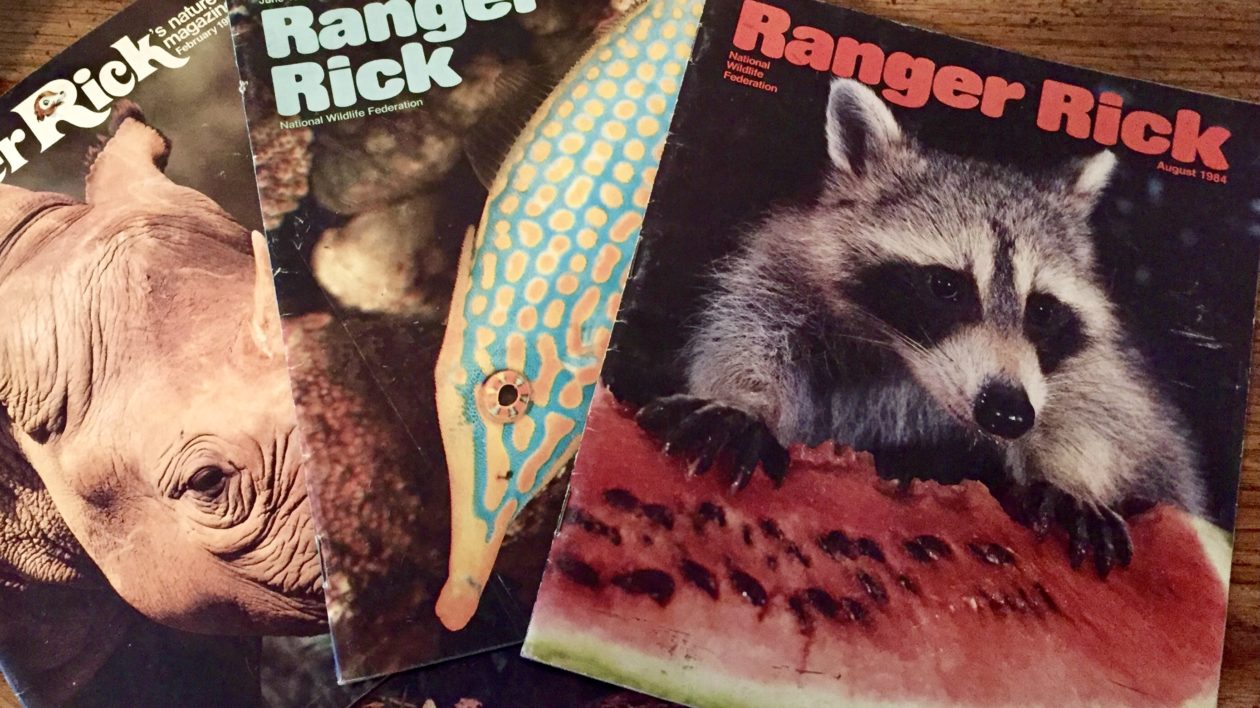
Shortly after moving to Ohio at age 11, some neighborhood kids quickly recognized my interest in wildlife, and gave me some old nature magazines. Ranger Rick. A kids’ magazine published by the National Wildlife Federation featuring animal stories guided by a raccoon mascot of the same name. Many of you are probably familiar with it; the magazine has been around for more than 50 years!
One day while leafing through a well-worn issue, I flipped the page and something caught my eye: a small illustration of two softshell turtles! At the time, my favorite animals were freshwater turtles, and anything about them commanded my attention.
But when I zoomed out beyond the tiny turtles, I saw the focus of this two-page spread was something else. Something ancient and beastly, like an alligator with fins instead of legs: it was a giant fish called an alligator gar.

My curiosity was piqued by this new “discovery,” its prehistoric appearance, armored scales, and huge jaws with lots of teeth. It reminded me of an aquatic dinosaur. I forgot about the turtles and proceeded to read the short story, “The Mississippi King,” about one of North America’s largest freshwater fishes, and how their lineage has been around since the dinosaurs! This stealthy predator could grow over six feet long, weigh more than 200 pounds, and it breathed air. I was instantly hooked on gars.
As an 11-year-old kid with an ever-expanding interest in all things “creature,” I at some point lost sight of those dinosaur fish. I went back to the turtles. By high school, I even lost that Ranger Rick magazine, but the image of the infamous Mississippi King remained emblazoned in the back of my mind for many years to come.
By my junior year as a premed biology major at Ohio Northern University, I had “sneaked” classes like invertebrate zoology and biological photography into my schedule, alongside requirements like human anatomy and physiology. I realized field biology was where my true passion resided, not pre-medicine. I decided to attend graduate school and planned to study herpetology (reptiles and amphibians), including the turtles I’d been fond of growing up.
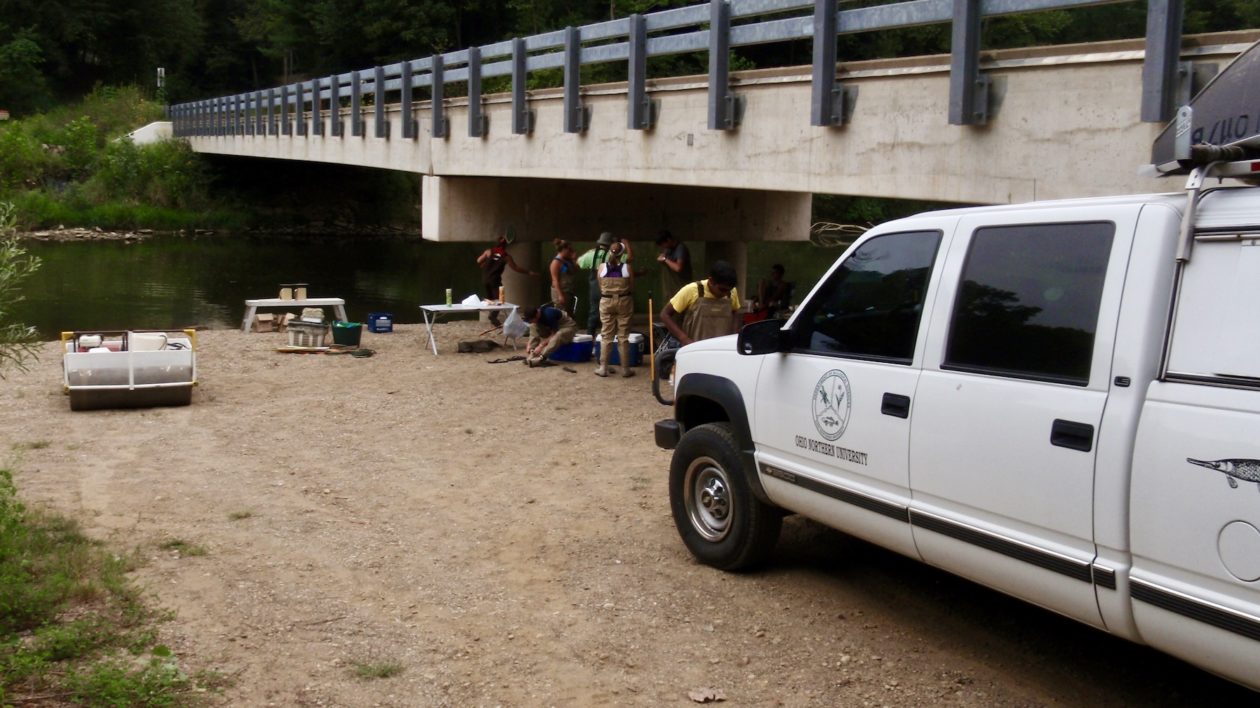
The following year, however, I took a class called ichthyology (biology of fishes), and my biological focus shifted again. I wanted to study fishes. I was good at identifying and catching them; and fish diversity, particularly in freshwater, fascinated me.
Nearly half of the approximately 32,000 described fish species live in less than 1% of the world’s water! My ichthyology professor was especially fond of an unusual fish; he even had a decal of one on the university field truck. An elongate animal that looked like an alligator with fins instead of legs. Professor Keiser was a fan of gars, and then I recalled that I was too. We never caught a gar in that ichthyology class, but I did well studying other species and earned an A in the course. And I remembered the gars. What cool fish!
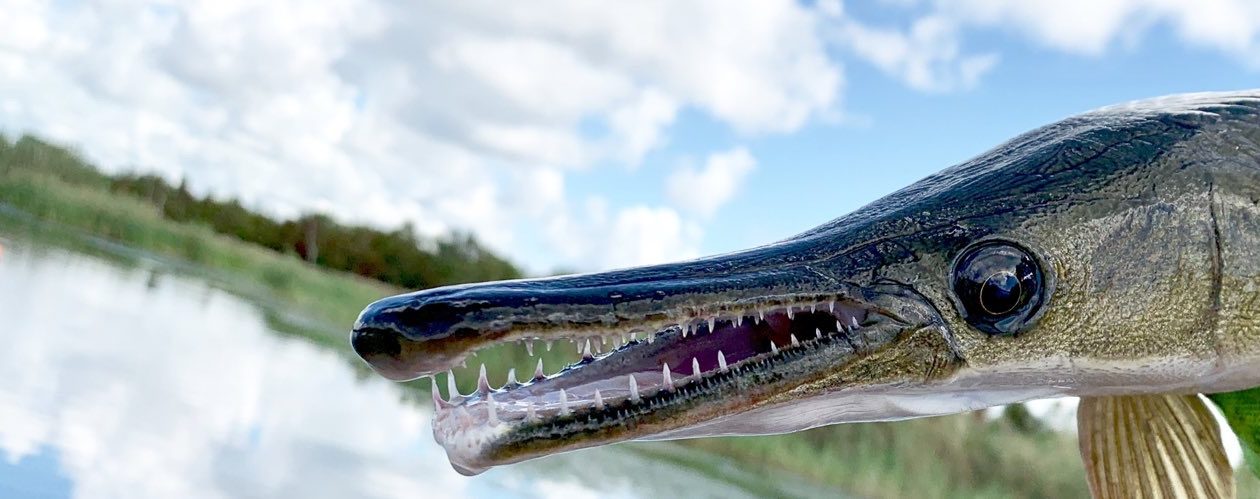
The next fall I began graduate school at the University of Michigan’s School of Natural Resources and Environment, studying fish ecology. I managed to incorporate longnose gars into my master’s thesis on riverine fish communities, and my doctoral dissertation focused on spotted gars at the edge of their range.
My obsession with these fish returned in a gargantuan way.
I dove deep into all things gar while in graduate school: gar conservation, gar aquaculture, I even kept gars in aquariums at my apartment. I learned that gars had an undeserved, bad reputation. Anglers often called gars “trash fish” and they were often killed to “protect” more desirable sport fish like bass. Sometimes gars were simply target practice for bowfishers. Through my research and science communication, I wanted to show people that gars were valuable components of native ecosystems, not trash fish.
I always remembered that Ranger Rick article, and how I’d lost it. Recovering that article became another obsession, a quest. Over holiday breaks at home I’d dig through old boxes, trying to find that missing magazine. I couldn’t remember what was on the cover, so I leafed through each page of every issue I could find. The next holiday home, I’d go through them again, in case I had missed something.
I expanded my search online, looking for back-issues of Ranger Rick on eBay in between thesis writing. My parents and friends tried tracking down the issue for me too, but were unsuccessful. I started casting an even wider net; I mentioned my garish inspiration in blog posts and interviews. The Chicago Sun-Times even mentioned I was on a quest to find that elusive magazine! But still no bites.
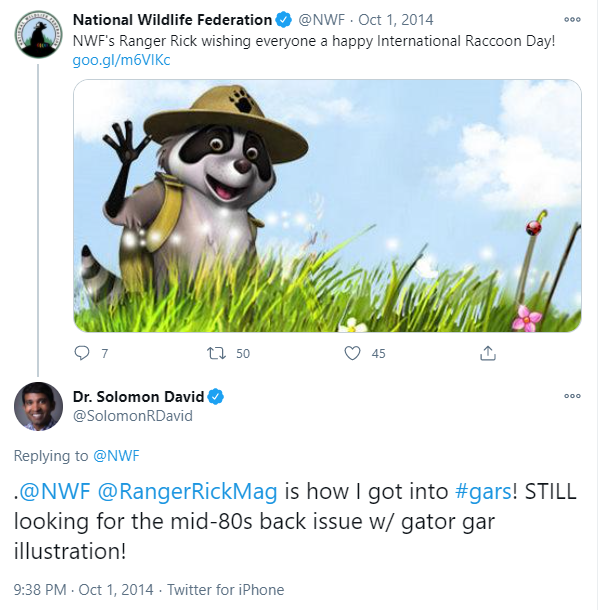
Years after graduate school, as a postdoc at Chicago’s Shedd Aquarium, I was working on a story about a recent gar-spotting, a surprising find in the Chicago River. I broke from writing to check Twitter, and noticed a tweet by the National Wildlife Federation, including an updated, but still familiar raccoon.
It was Ranger Rick. To celebrate “International Raccoon Day,” the tweet featured a picture of the magazine’s mascot. Although my quest had waned over recent years, I appreciated the nostalgic reminder. I tweeted at National Wildlife Federation and Ranger Rick about how their magazine inspired my interest in gars as a kid, and that I was STILL searching for that long-lost alligator gar illustration. Tweet sent, I left the office, and went home to bed.
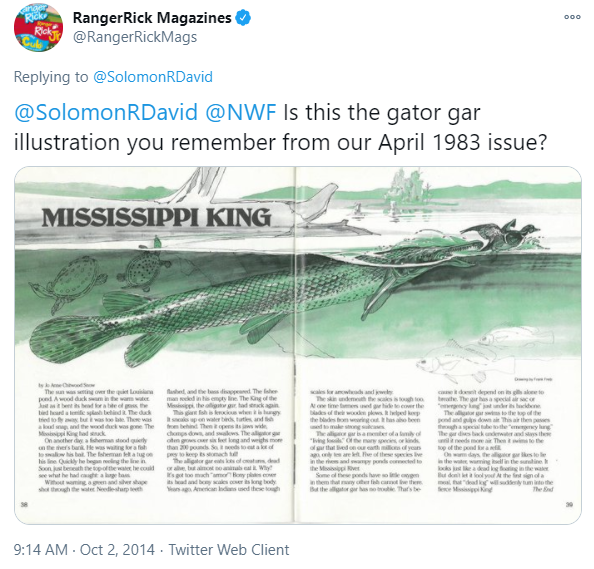
The next morning I received a reply on Twitter from Ranger Rick Magazine:
“Is this the gator gar illustration you remember from our April 1983 issue?”
And there it was. Attached with the tweet was the familiar form of an alligator with fins instead of legs, complete with two little turtles. “Mississippi King.”
I was floored, I teared up, I couldn’t believe it. After SO MANY years.
“YES!!! THAT IS IT!! I’ve been looking for that for over 20 years! THANK YOU SO MUCH! THIS IS INCREDIBLE!!!”
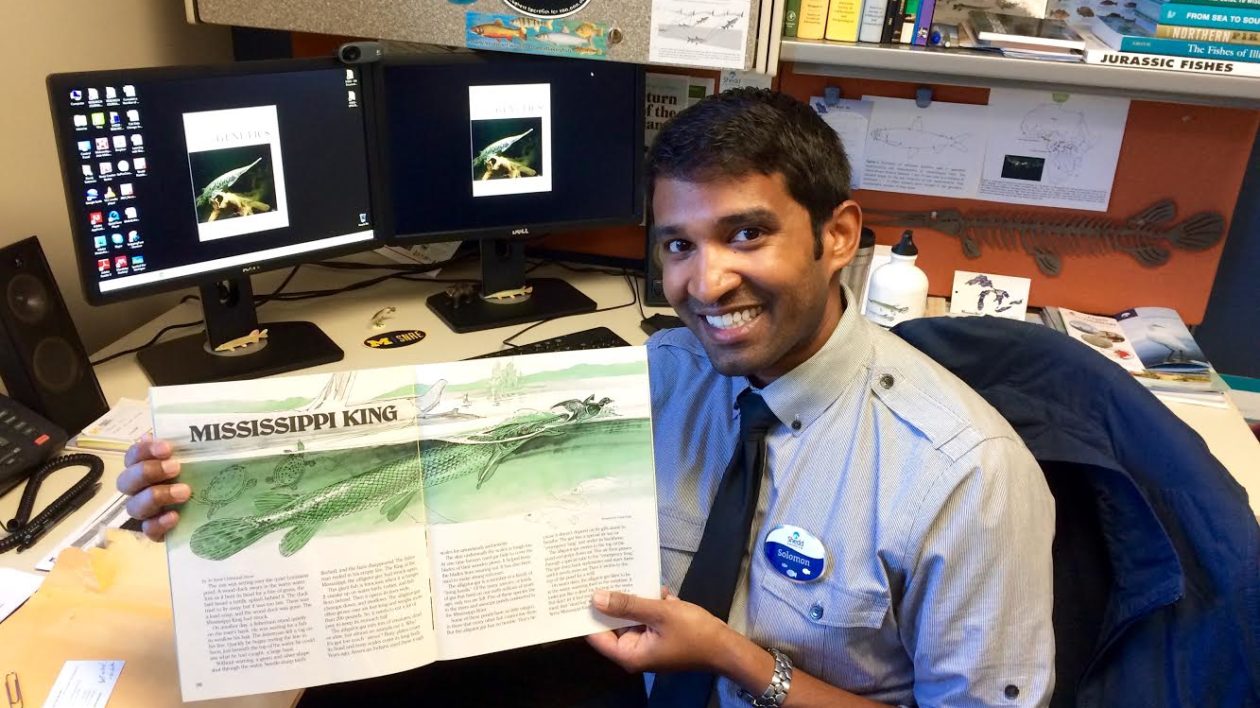
I was so excited I had to tell everyone I knew. I texted my parents, my sisters, my future wife. I saved the image file of that gar story in at least 10 different locations so I would never lose it again.
I sent a message to Ranger Rick briefly explaining my epic quest and asked if they would be willing to send me a PDF of the article, or if I could purchase a hard copy of the issue itself.
Ranger Rick got back to me and I was in for another surprise; they had one extra copy of that 1983 issue in their archives and they were going to give it to me. I couldn’t believe it, and I was soon reunited with the original garticle.
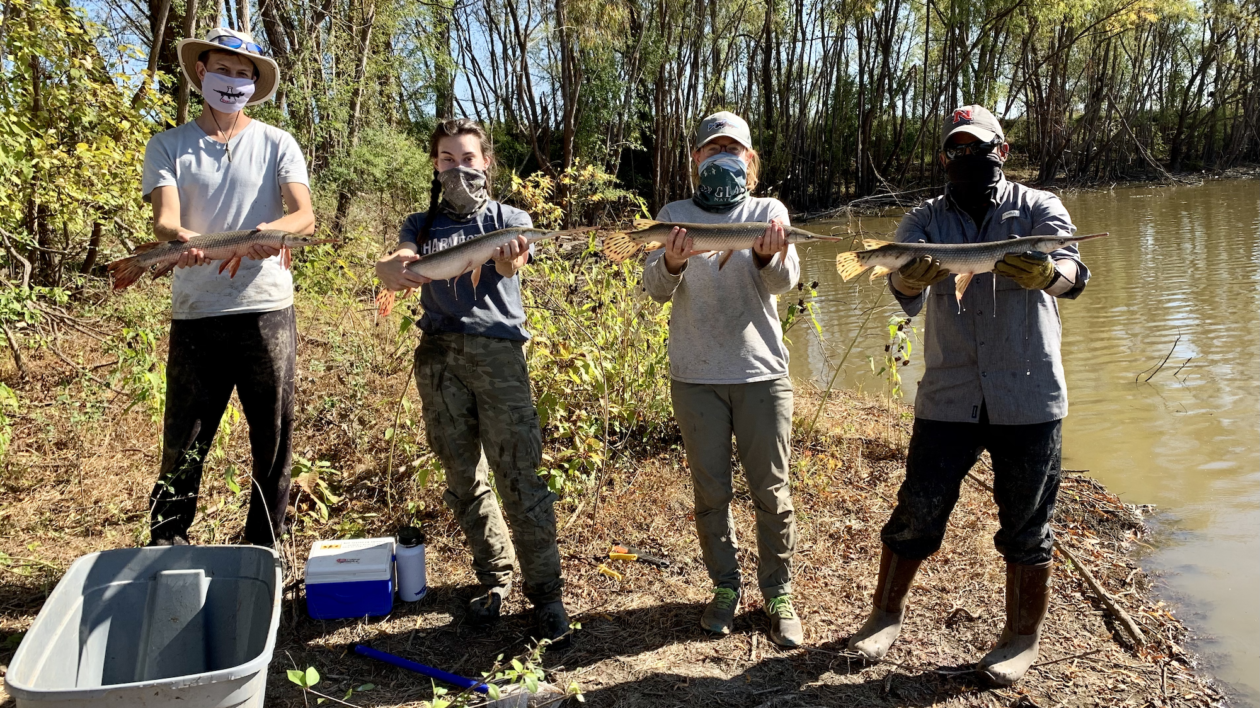
Several years later, I became an assistant professor of biological sciences at Nicholls State University in Louisiana, where I started GarLab. Our team studies the ecology and conservation of freshwater fish biodiversity, with a primary focus on, you guessed it, gars. I’ve shared my Ranger Rick “origin story” with friends, colleagues, students, even at professional conferences. Being inspired by a fish tale in a kids’ nature magazine, making a career of studying (and defending) those unusual fish, and then reconnecting with Ranger Rick. My quest felt complete.
But there was still another chapter in this story.
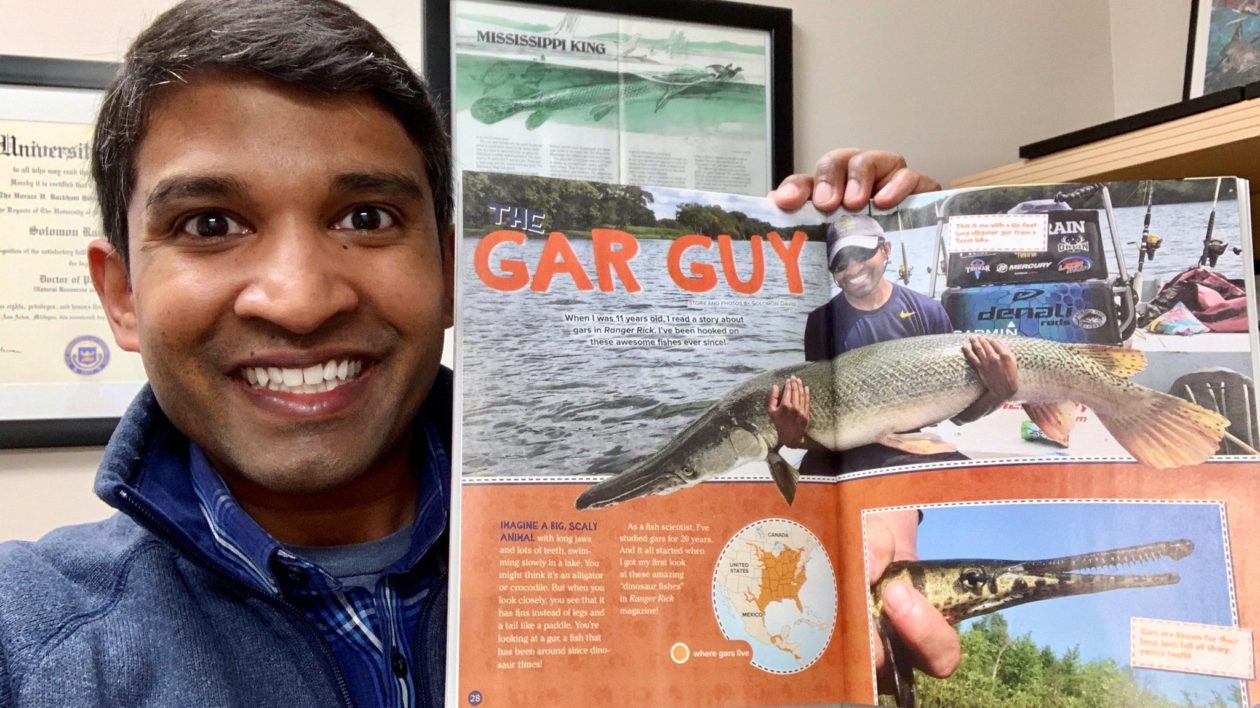
Earlier this year (February 2020), Ranger Rick published another story, again with a big alligator gar spanning two pages, but this time the article was written by me. Although the story’s primary focus was the natural history of these living fossil fishes, Ranger Rick’s editors titled it “The Gar Guy” and made sure I incorporated my personal connection with these fishes and the article that started it all.
It’s been a dream come true, and it’s the publication I am most proud of. I hope the latest Ranger Rick gar story helps inspire a new generation of young people to learn more about the natural world, including an appreciation for those lesser-known, unusual “creatures.”
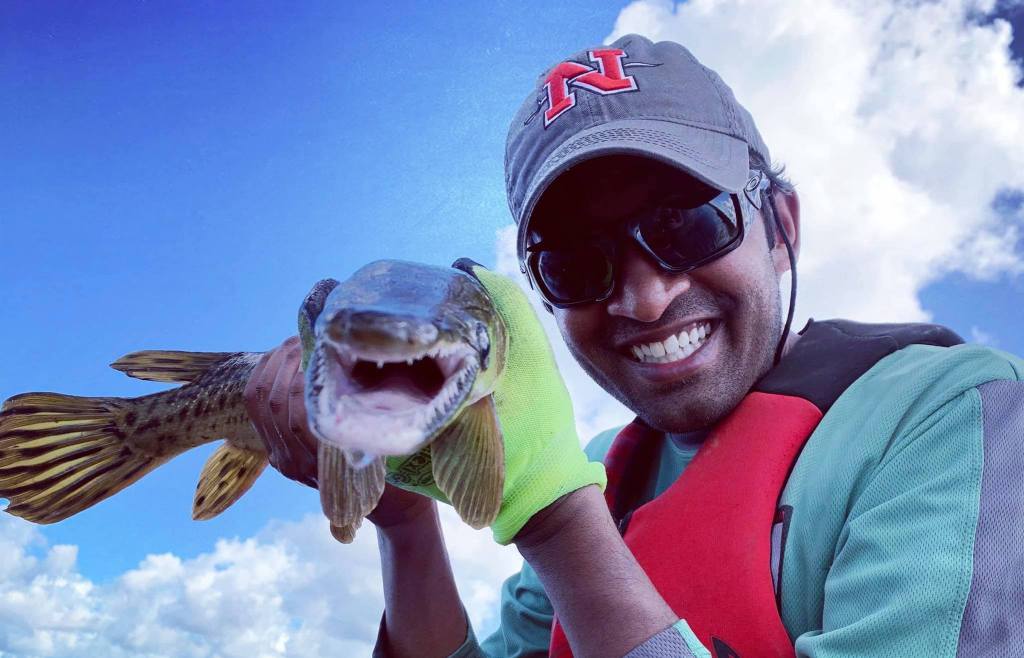



I was looking for Ranger Rick too, because of the positive effects I believe the magazine had on my own life, and happened upon this wonderful article. So happy you were able to find the original article and how wonderful about your own “garticle”! So pleased to have happened upon your story. All the best.
I loved reading Dr. Solomon David’s origin story! I too grew up reading Ranger Rick. All that I learned from Ranger Rick steered me to choose a career in fundraising for environmental organizations. I was so thrilled to have the opportunity to work at the National Wildlife Federation from 2004-2009, and currently raise funds for the National Park Foundation. I appreciate the commitment and creativity of the staff who write and design the magazines. A big thanks to Gerry Bishop, Mary Dalheim, Lori Collins, Hannah Schardt, Susan McElhinney, Ellen Lambeth, Robin, Cindy Olsen, Thuy Senser, Chris Conway, and many others for inspiring so many young people to share your passion for wildlife and nature. I now read Ranger Rick Junior to my niece who loves it just as much as I do.
Was great reading your article. I subscribed to Ranger Rick for my children as they were growing up and we lived in the country. They loved the magazine and i believe it gave them a greater appreciation and respect for the wild animals around us. So good to see that it helped you with your dream and occupation. Keep up the good work and putting the spot light on the less appreciated creatures in our wonderful world.
Oh my goodness how I love this story! I also would devour my Ranger Rick’s as a child, obsessing over the illustrations. My issues are long gone, but as an ecologist with The Nature Conservancy, I feel like those magazines are still a part of me. It’s so heartwarming to read about all these fellow child nature lovers! And it’s so wonderful that not only have you been reunited with your favorite issue, but now you’re featured in your own – way to go!
Solomon, I can completely relate. I grew up with a multi-year subscription (thank you Mom and Dad!!) to Ranger Rick, and i know it was instrumental in my passion for wild creatures and wild lands. My career from 1985 to present (at the outset, i sure didn’t consider it a career!) has taken me to many amazing places, on several continents and across the Western USA. Thank you for taking the time to write this up — a true bright spot in my day.
regards,
Jeff Fields, Zumwalt Project Manager, The Nature Conservancy in Oregon.
Thank you for sharing this wonderful story! Ranger Rick was also very formative for me in developing my love for nature and desire to pursue a career in the environmental sciences!
Thanks for sharing your story, Dr. David! I also grew up reading Ranger Rick and I’m sure that’s at least partly why I’ve been working for The Nature Conservancy for over 25 years.
This is a terrific piece – great story and well written! Huzzah!!!
I LOVE THIS STORY! And I loved Ranger Rick magazines. I remember at the time thinking all of those modernistic Charlie Harper illustrations (they may have been before your time — that gar image is not one of them) of complex habitats and different conservation issues were weird but cool — and now I’m kind of obsessed with his work. I wonder if kids tending sheep in Minecraft will have anything close to that level of influence — but I bet you have hooked some new kids with your article!
Thanks for sharing your story, Solomon. Your enthusiasm for your work is inspiring, and I’m sure you’ll pass that passion on to future generations.
You’ve definitely piqued my interest in this unique fish.
Solomon and his students are helping TNC understand how floodplain restoration impacts fish biodiversity on one of our big projects in Mississippi. He and his students are also documenting reproduction by alligator gar on the reconnected floodplain. He’s a superstar.
Great article, my friend!
What a great story! Thanks so much for sharing!
Wow!! Quite an interesting and inspiring story Dr. David. Thanks for the clear way of communicating science to the general public.